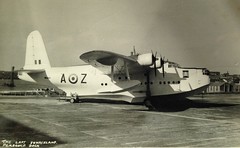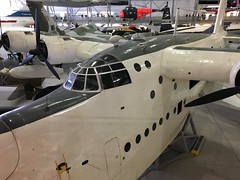In Trail 59, we head to the northwest of the country, to an area of outstanding natural beauty. It is an area made famous by its many hills and lakes. It was the home of Beatrix Potter, Arthur Ransome’s series of books Swallows and Amazons; several water speed records, and it is a mecca for tourists flocking to “get away from it all”.
Surprisingly then, it is an unlikely place for aviation, yet it was up until the end of the Second World War, a major player in Britain’s aviation industry, utilising one of the vast lakes for that spectacular machine the flying boat.
In Trail 59 we head to the Lake District, and Lake Windermere in particular, where there are two sites linked to Britain’s aviation history. The first, at Cockshott Point, is where the aviation link began, whilst the second, White Cross Bay, is where the more substantial part of the trail takes place.
Windermere.
(RNAS Windermere/Cockshott Point / RNAS Hill of Oaks)
Lake Windermere (as it is incorrectly known) is the largest of the 16 bodies of water in the Lake District, and at almost seventy metres deep, eleven miles long and just under a mile wide, it is actually classed as a ‘Mere’, and not a lake. It is however, probably the most famous of all the Lakes, Meres or Tarns in the district and certainly it is the most visited. In 2018, Windermere helped draw more than 19,000,000*1 visitors to the area, many taking up recreational activities on its 14.8 square kilometres of water.
Windermere’s aviation connection began in 1911, when a civil engineer, Oscar Gnosspelius, and a barrister, Captain Edward William Wakefield, began trials of flying from water both men using Windermere as their base. Progress for the two was slow, each finding out for themselves the perils of trying to take off from water. Both men trove to be the first to achieve this challenging task, and both found the many difficulties of such an action.
After many failed attempts of breaking the water’s hold over these ‘hydro-aeroplanes’, both Gnosspelius and Wakefield reached a point where they believed take off was truly possible, all it needed was good weather.
The notoriously poor climate of the Lakes finally broke, and on 25th November 1911, Gnosspelius made his attempt first. After steering his aircraft along the water, lift was achieved, and it momentarily rose from the lake only to have the wing strike the water bringing the aircraft and Gnosspelius crashing down.
Wakefield meanwhile, had teamed up with a Rolls Royce engineer, 27 year old Herbert Stanley Adams, whilst he was based at Brooklands. Wakefield had offered him the job of test pilot, which Adams duly accepted. On the same day that Gnosspelius made his attempt, Adams took Wakefield’s aircraft, an Avro adapted Curtiss biplane, out onto Windermere water. The first run failed to gain any lift at all, but then, on his second run, he turned the craft and headed north. Now with a good headwind, the aircraft broke the surface tension and it gradually rose from the water flying some 50 feet or so above its surface. History was at last made, and Adams became the first man in the UK to fly an aircraft that had taken off from water*2
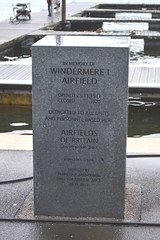
November 25th 1911, the date Adams took off from Windermere and flew the first UK flight from, and back, to water.
And so, Adams’ achievement set in motion a series of events that would lead Windermere on a long, and difficult path to aviation history. As confidence grew in waterborne aviation, more and more flights were made which soon led to the formation of the Lakes Flying Company. All this activity and the noise from albeit small aircraft engines, inevitably led to vehement objections from many locals including Beatrix Potter herself. These objections were so strong that organisations were set up to oppose the continuation of flying. Support for them rapidly grew, and soon they had amassed over 10,000 signatures in their support. But the argument in favour of flying was also strong. Many had the foresight to see where flying from water could lead, and in April 1912, the Government made the decision to allow further flights from Windermere, a decision that enabled Wakefield to continue with his business endeavour.
Fearing other nations were also trialling flight from water, especially France, the Government debated at length the need for such measures. During one such debate, the Rt. Honourable Mr. Joyson-Hicks directed his questions about France’s progress in hydro-planes, directly to the then 1st Lord of the Admiralty, Winston Churchill.
Mr. Joyson-Hicks asked Churchill how many such hydro-aeroplanes the British Navy owned. Mr. Churchill, in his answer, explained that there was indeed one under construction at East-Church, two others on order, and another thirty-two experiments with machines of this type occurring at: Sheerness, Lake Windermere, and at Barrow. He went on to explain that the results obtained so far from these trials “were promising“.*3
Gnosspelius meanwhile, repaired his damaged aircraft. Learning from his mistakes he modified it and retested it – it flew, giving him the lesser honour of becoming the first person to fly an aircraft built solely in Cumbria; albeit in the shadow of Adams’ and Wakefield’s triumphant achievement.
By the time World War I arrived, the benefits of taking off from water were well and truly clear, the Royal Naval Air Service took a great interest in the exploration seeing a future for water borne aircraft within their service. Wanting to perform their duties, both Adams and Gnosspelius joined up, leaving the company without anyone to lead it. Seizing on the opportunity, it was bought out by William R. Ding, an instructor who had been brought in by Wakefield, and had also realised the potential of taking off from water. In light of the RNAS’s interest, he could see profit in training pilots to perform the task. Eventually, so keen to investigate and carry on the idea themselves, the RNAS requisitioned the company and took over the site renaming it RNAS Hill of Oaks.
Many of the civilian staff who were already employed on the site remained for the time being, but when the last individuals left in 1916, it became a naval base, and as such was renamed again – this time the more appropriate RNAS Windermere. Training continued under the supervisory eye of the RNAS, but eventually, as the war approached its end, operations from Windermere began to wind down. Predictably, it reached a point where flying ceased altogether and the RNAS departed the site.
This could well have been the end of the line for Windermere, but a short reprieve in 1919 saw the once famous 1914 Schneider Trophy air race pilot, Charles Howard Pixton, return to the site. Utilising Avro 504K floatplanes, he set up and carried out tourist flights, which he combined with an newspaper delivery service to the Isle of Man. These operations breathed new life into waterborne flight, and in particular, into Windermere.
Eventually though even these ceased, and during these post war years, flying activity gradually declined at Windermere, and apart from a few recreational flights onto the water, it eventually ceased altogether. With this, the final flight had been made, and Cockshott Bay, a place unique in British aviation history, would no longer resound to the sound of aircraft engines. This part of Windermere’s aviation life had come to an end.
Now a major marina, only a tiny section of slipway remains, its access is difficult even for boat owners, primarily due to its location. It is rather sad, especially considering the importance of this site that nothing more tangible remains (a memorial stone from Airfields of Britain Conservation Trust is nearby) to commemorate the incredible deeds of Adams, Wakefield and Gnosspelius, who between them took Windermere into the annals of aviation history.
The second site visited today lies a few miles north from here, also along Windermere’s eastern bank. It is this site that is perhaps the more prominent, and perhaps the more defining, of the two. From here we take a short trip north stopping off at White Cross Bay.
Windermere White Cross Bay.
In the intermediate war years Windermere remained as it was, tranquil and aviation free, but once war broke out things would change.
With increased bombing of Britain and in particular the growing threat to aircraft production in southern England, the Ministry of Aircraft Production (MAP) began studies into creating new factories in safer areas away from Kent and the south. Short Brothers at Rochester was one such organisation identified for expansion. Primarily home of the Stirling bomber and located not far from London, it was a high risk location, and it was within easy reach of the Luftwaffe’s bombers. In response to the need for expansion and relocation, the ministry turned their attention to Windermere, ordering an immediate feasibility study*4 into the move.
With just three Sunderland Squadrons at the outbreak of war, the defence of shipping and anti-submarine patrols needed a major boost. Production of Sunderlands, Short’s long range Flying boat, had to be increased, and so it was decided, that a new factory independent from Rochester, would be constructed at Windermere. At 75,000 sq ft, it was to be the largest single span hangar in the country, and it would be at a huge cost too.
As had happened before at Windermere, local objections became a major issue. The thought of the beauty and tranquillity of the landscape succumbing to both an aircraft factory and housing for some 1,200 workers, would not be without its consequences. Other suitable sites were given due consideration too, but with Rochester coming under attack from German bombers, the Government were pushed into making a decision and quickly. On 16th December 1940, it was confirmed, and the go ahead to build at Windermere was given, albeit with some concessions. It was agreed between the Government of the time and the local population, that the factory and all its associated buildings, would be removed once the war was over and the site was no longer needed. A concession that sadly led to virtually nothing of this remarkable venture remaining visible today.
Over the next two years, building work progressed, jigs were brought in and new specialist tools were ordered. There were in essence, two main buildings for the production process, the factory where the various parts were made, and an assembly hangar where the aircraft were fabricated. A third area located at Troutbeck Bridge (subsequently referred to as Calgarth), consisted of a range of accommodation blocks and associated buildings, it was in fact, an entirely new ‘village’.
Known as the Calgarth Estate, it would have everything from two shops to a primary school, a laundry to a football team, it even had its own Policeman! The estate was set out in a semi-circular design, with rows of houses around the outside. The canteen, assembly hall and school were all located withing the centre of the site next to a large and open recreation ground.
Building a flying boat is probably more like building a boat than an aeroplane – rather than fixing stringers over bulkheads allowing the aircraft to be built in sections and pieced together, the Sunderland was built from the keel upwards.
The Sunderland (a pure flying boat) was a massive aircraft, 112 ft in span, 85 feet in length and standing 32 feet high (to the top of the fin), it could fly for some 13 hours with a range of 1,700 miles. With a crew of up to 15, it was an ideal sub-hunter and long range maritime escort. Its hull was a single step hull, with two decks; the upper for the flying crew, and the lower a storage area for bombs and depth charges. Being such a large hull, it also had a wardroom, galley, cooking and washing facilities.

ML824 at the RAF Museum Hendon. Depth charges/bombs were extended out onto the wings from inside the fuselage.
By April 1942 the first hulls had begun to be assembled. Even the enormous hull of the Sunderland was dwarfed by the size of the hangar. The first RAF allocated aircraft, DP176 began construction in April. The jigs were cemented into the ground and the construction process began with six keels being formed. A skeletal fuselage was built up, and then treated aluminium panels (Dural) were added using rivets.
Even though the site at Windermere was huge, the wings, like the engines, were pre-built and delivered to Windermere for adding to the hulls. Space inside the wing was tight, the only way to access internal wing parts (control rods for example) was to crawl inside the wing and work in the very confined space between the two surfaces. Many workers, proud of what they had achieved, left their names inside the wing using a pen.
Each Sunderland built at Windermere (all MK.IIIs) was ‘hand made’, panels bent and riveted, most by hand rather than machine, so that each one was unique. Operating on water, each aircraft had to be water tight, this being tested from the inside under pressure, and any that were not, were stripped down and rebuilt. It was extremely noisy work, mainly using a non-skilled workforce recruited primarily from the local area. As skilled labour was in very short supply, and Short Bros, at Rochester couldn’t afford to let their skilled work force go (many were working on the RAF’s heavy bomber the Stirling) women and youths were drafted in (as part of the Governments recruitment plans) to fill those spaces left by the men who had joined up.
This meant extensive training programmes had to be delivered, and it became a frustrating time for those employed at the site. But, over time, things settled down and production got into full swing, the workers united and a ‘family’ was formed.
Once complete, the aircraft was rolled out using a special tail-trolley with beaching wheels attached to the fuselage sides beneath the wings. As a pure flying boat, the Sunderland could not easily move under its own power whilst on land, but had to be towed by a small tractor. Once in the water, it cold move using its engines and rudder, but having no water rudder meant it was difficult to manoeuvre. To help, two drogues were used, located either side of the fuselage and passed through the galley windows. These 3 foot wide drogues could catch huge amounts of water, pulling a large cable and a man’s hand with it – if care wasn’t taken. Each man would throw one of the drogues out of the open window and drag it through the water to turn the aircraft, rather like how a canoeist does today. These methods, whilst primitive, were effective.
Once out of the hangar, the aircraft were lowered into the water, and the beaching gear was removed. The aeroplane was then towed, by boat, out onto the Mere where they were moored to buoys. To assist with this, the front turret could be withdrawn into the hull and a crew man would lean out and grab the mooring rope using a hook. Moving the aircraft into and out of the water was a tricky job indeed, and required great skill so as to not damage the hull of the aircraft through grounding.
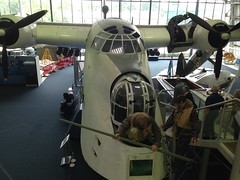
Sunderland ML824 at the RAF Museum Hendon showing the front turret withdrawn to enable mooring. Notice also the maintenance panel in the wing, lowered to allow maintenance whilst moored. My father would fasten cork to his tools in case he dropped them into the water.
On September 10th 1942, the first aircraft, DP176, finally left the hangar ready for engine runs and its first flying test. Lashed down to the slipway, the four Bristol Pegasus XXII air-cooled radial engines were started up and ran. After a successful test, the test pilot John Lankaster-Parker, took the aircraft onto the water where it was moored ready for further tests, and its first flight the following day.
The next day, 11th September 1942, the workforce were given the day off to witness their first Sunderland’s flight. As Short Brother’s own test pilot John Lankester-Parker (who also flew the first Stirling) climbed aboard with a selection of technicians, a large crowd gathered outside the factory. The buzz of seeing the first Windermere Sunderland, was met with cheering and clapping as it gradually rose in to the air. After twenty minutes, Parker returned to the water and all was reported to be well. After further flying tests, DP176 was passed to RAF control, and taken away to have its electronics fitted before commencing operational flying duties with the RAF.
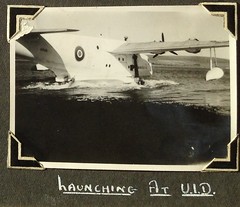
A post war picture of a Sunderland launching (photo my father) either Wig Bay or Stranraer. Does anyone know what U.I.D might mean?
The ‘Flying Porcupine’ as the Sunderland was known, became the backbone of Coastal Command operations, a sturdy reliable aircraft it was used as a model for the RAF’s Stirling bomber (less successfully) and went on to be the basis for the Short Shetland, a flying boat that dwarfed even the Sunderland.
In January 1944, Sir Richard Stafford Cripps*5, now the Minister of Aircraft Production (after Churchill had removed him from the War Cabinet for criticising his policies on war) visited Windermere to see the site and meet with the management team. The visit, unbeknown to those at Windermere, had an ulterior motive and in his meeting with the managers he announced that all production at the site was to stop with the last few fuselage frames in the factory being the last. It was a devastating blow for the workforce, but it was not however, the end of Windermere. As part of the change, the factory was to be retained and utilised as a Civilian Repair Organisation (CRO) repairing and updating older Sunderlands rather than building new ones.
The job of repairing the aircraft brought home to the workers just how bad things could be. Worn out, damaged and battered aircraft flew into Windermere to be repaired and returned to service. In some cases, women were not allowed entry into the aircraft until the blood and human remains had been removed, such was war. Some aircraft came only to be scrapped, taken apart by the axe, any usable parts were saved and reused on other less worn models.
A number of these damaged aircraft passed through Windermere, many due to action with the enemy, but some due to accidents. Those that were repairable were hauled into the factory on the beaching gear, stripped and repaired. Some were converted into MK.Vs, having new engines fitted with feathering propellers – over heating engines had been an issue on some long flights.
The CRO carried out repairs on Sunderlands, until the war’s end. In 1945 a new direction was taken and upgrading work took over as the main task for the workers. MK.IIIs were brought in, stripped and upgraded to MK.Vs. New Pratt and Whitney Twin Wasp engines were installed, the dorsal turret was removed, and two gun mounts were added to the insides of the fuselage behind the wings. In addition, to extend longevity all of the control cables were replaced.
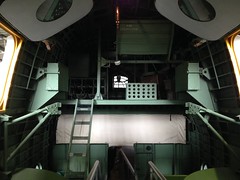
Inside the Sunderland looking forward. The two brackets either side are the gun mounts of the MK.V, the turret having been removed and replaced.
The Sunderland gained the nickname ‘Flying Porcupine’ (Fliegendes Stachelschwein), generally thought so because of its extensive array of aerials. Alternatively, it gained its name from the Germans who fell foul of its powered gun turrets. It is also thought however, and more likely, that this naming was more to do with British propaganda than anything else, as the name appeared in print before any real skirmishes had occurred between RAF and Luftwaffe aircraft.
At the beginning of the Second World War, Coastal Command had only thirty-four Sunderlands on their books, but by the end almost 750 had been built, the majority being MK.IIIs, serving well into 1959. There were four military marks built: MK.I, MK.II, MKIII. and MK.V. The MK.IV being an upgrade of the MK.III with heavier guns: (.50 inch machine guns and 20mm Hispano Canons); a larger tail; longer fuselage and bigger, stronger wings. It also had in addition, more powerful Bristol Hercules engines. It was then considered an entirely new aircraft, and so received the designation S.45 ‘Seaford’. Only 8 examples were ever completed, all of which arrived too late to see combat duties. None of those constructed making it beyond trials with the Royal Air Force.
The last Windermere Sunderland worked on, ML877, arrived from 228 Sqn on April 4th 1945, along with NJ171 to collect and return the crew. The aircraft was upgraded to MK.V standard after which it was taken away and returned to operational duties.
With that, Windermere’s aviation history closed. By the time production had ceased, Windermere had produced thirty-five aircraft equipping seventeen front line RAF Squadrons, along with Maintenance Units (MU) and Operational Training Units (OTU). Their service stretched as far as West Africa, Hong Kong and of course bases around the shores of the UK. One of the biggest ‘users’ was 57 MU / 1 FBSU (Flying Boat Service Unit) at Wig Bay, whilst others ended up at Pembroke Dock – both of which my own father was posted to, to work on Sunderland Flying Boats, I wonder if he came across any of these.
Workers from Windermere were transferred to either Rochester or Belfast, others stayed in the area to find alternative employment. After being nationalised by the Government during the war, Shorts in Rochester was closed and all production moved to Belfast. It was eventually taken over by the Canadian company Bombardier. It is believed that some aircraft parts along with general rubbish were dumped into Windermere to dispose of them, and rumours of complete aircraft being scuttled there have long since drawn divers to the area in search of these hidden wrecks. These are unfortunately unfounded, those who worked at the site have not given any credence to the myths, and so it remains a sad truth that the Windermere Sunderlands are indeed now just a part of history.
Back at the Windermere, the Government’s agreement to remove the buildings wasn’t implemented straight away.
In August 1945, the British government agreed to give refuge to 1000 child sufferers of Nazi concentration camps. 300 of them were brought to the Calgarth Estate, the former Short’s accommodation area, where a team of counsellors and volunteers had been assembled hoping to rehabilitate them.
The (4 month) pioneering project run by Oscar Friedman at Windermere, aimed to rehabilitate the children, allowing them to lead a normal life in society once more, after the horrific treatment they had received in the various concentration camps under the Nazi regime.
On arrival the children were separated into girls and boys, asked to remove clothing and given a medical examination. Some, fearful of what had happened before believed they were going to experience similar atrocities. Others were more forgiving and more hopeful. Their clothes were burnt, they were deloused and then the children were fed.
The former flying boat site provided accommodation for the workers, this accommodation would now house the refugees, each older child having their own bed, in their own room. A far cry from the squalid bunks of the concentration camps.
With the freedom of coming and going, even simple things frightened the children. A dogs bark or a uniform could mean the difference between life and death. Their nightmares would linger on for years to come.
During the day, they attended classes, English and sport along with therapy sessions using art as a medium through which they expressed their emotions. The pictures they created reflected the brutal suffering and emotional damage that the Nazi regime had inflicted upon them. Not the happy blue skies and sunny landscapes a ‘normal’ young child would have created.
Very soon the Red Cross brought the devastating news about their families:. Brothers, sisters, parents who had all perished in the various death camps across Eastern Europe. This was another blow to those who were either located here or worked here.
By the time the children were able to leave they had formed great friendships. In all, 732 children passed through British ‘camps’ all going on to make independent lives for themselves. Many set up businesses here in the UK, some in the US. Of those who stayed, many received accolades – an MBE and a knighthood being among them.
Windermere was a place of salvation, of peace and harmony. The journey was a difficult one, but after the horrors of the German concentration camps it brought life, love and lasting friendship to many heartbroken children.
Even though the local people had grown to liking the new factory, eventually the agreement made between them and the Government, to remove the buildings and all trace of the factory, was carried out. In 1949, the factory element was pulled down, leaving the accommodation area to continue on well into the 1960s.
In July 1990 the world’s last flyable Sunderland flew over Windermere visiting White Cross Bay. ML 814 (known as ‘Islander’), was a Belfast built Sunderland, and served with the RNZAF after the war. She also served as a civilian aircraft operated by Ansett Airlines. She was given permission to land on Windermere during the 1990 Windermere Festival, whilst the then owner Edward Hulton was looking for a permanent base for the aircraft. Sadly it was not to be, the authorities in 1990 were less keen than their predecessors to have large four engined aircraft on the water, and so the aircraft departed eventually being purchased and transported to Florida’s Fantasy of Flight Museum.
Traces of the site remained for many years, but now only the slipway, odd patches of concrete and paths hint at its history. The Holiday camp built on the site has a small display of items to do with the factory, and the Airfields of Britain Conservation Trust have erected a memorial stone to all those who served here. The stone stands outside of the ‘club house’.
Once a conglomeration of buildings, it is now a huge holiday park; how many of those who stay here I wonder, give more than a passing glance at the historic value of this once busy and noisy place.
Post Script.
For years rumours of scuttled Sunderlands proliferated around the aviation world drawing divers to explore the depths of Windermere in search of the wrecks. Whilst aircraft were indeed taken apart at Windermere, it would seem none were actually scuttled here and the rumours of such events were indeed just that – rumours. Perhaps they were created by locals wishing to extend the longevity of Windermere’s historic links, or perhaps they were created out of the minds of ex-workers misguided by fading memories. Whatever the origin, it would be nice to think that at least one does remain down there waiting for the day it is discovered and brought back to the surface to rekindle Windermere’s history once more.
Both the Imperial War Museum (IWM) at Duxford and Hendon have a Sunderland Flying boat on display. At Hendon ML824, a MK. V was transferred from the French Navy to Pembroke Dock (see photo above) where it sat outside exposed to the elements for many years. After deteriorating it was transported to Hendon where it was fully restored and now allows public entry into the fuselage.
At Duxford, ML796, the first production MK.V went to Calshot on the Solent and then onto Wig Bay in 1946. After remaining in storage for three years she was also passed to the French Navy, serving until 1950 when she was transferred to Shorts Brothers in Ireland for modifications. Returning to France in 1951 via Wig Bay, ML796 served again until 1962 at which point she was struck of charge. Purchased privately, she was then unceremoniously gutted being turned into a discotheque and drinks club. She then became the charge of the IWM in 1976 where she too was refurbished. Like her surviving sister, she remains on public display, located in the Airspace hangar.
Both the Windermere site and the Sunderlands that were built there are no more, an important and decisive part of Britain’s aviation history has gone forever. With two models in Britain and less than five globally, the Sunderland is an iconic aircraft that helped in Britain’s defence of Europe, and in the defence of her own borders. It’s such a shame that both this beautiful aircraft and the memory of Windermere, have been allowed to disappear from our skies forever.
Sources and further reading (Windermere)
*1 Lake District National Park Website.
*2 Whilst others had attempted, and to some extent achieved flight (both Gnosspelius and Commander Oliver Schwann at Barrow in Furness) Adams gained the title as he was the only one able to keep the aircraft under control, a pre-requisite for being the first.
*3 Fleet Air Arm Officers Association Website.
*4 National Archives AVIA 15/3622
*5 Spartacus Educational website
Uboat.net website. An excellent site dedicated to the U-Boat war.
English Lakes Website
Windermere Sunderland Flying Boats website.
Westmorland Gazette website.
Imperial War Museum website,
For further information on the production of Sunderlands at Windermere, including personal stories and photographs, I would suggest Allan King’s excellent book “Wings on Windermere“, published in 2008 by MMP.
